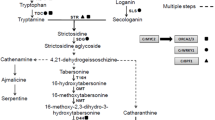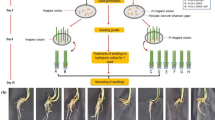Summary
Excised roots from aeroponic axenically 48 h dark-grown sunflower (Helianthus annuus L.) seedlings showed redox activities, being able to oxidize/reduce all the exogenously added electron donors/acceptors, that affected the H+/K+ net fluxes simultaneously measured in the medium. Trials were performed with in vivo and CN−-poisoned roots; these showed null+/K+ net flux activity but still oxidized/reduced all the e− donors/acceptors tested except NADH. NADH enhanced the rate of H+ efflux by in vivo roots, otherwise not changing any of the normal flux kinetic characteristics, suggesting that NADH donates e− and H+ to the exocellular NADH oxidoreductase activity of a CN−-sensitive redox chain in the plasmalemma of the root cells. K+ influx was not affected, probably because the NADH concentration was not very high. The e− donor HFC(hexacyanoferrate)(II) activated the H+ efflux in a very different way: maximum H+ efflux rate was maintained, but both the maximum rate plateau and the optimal pH range were extended, and hence the total H+ efflux was significantly enhanced. At the same time, the K+ influx was doubled. The different H+-efflux kinetics, together with the small but significant HCF(II) oxidation by CN−-poisoned roots, were taken as evidence that, besides the CN−-sensitive redox chain, an alternative CN−-resistant redox chain in the plasmalemma was involved in HCF(II) oxidation. The effect of the oxidized form HCF(III) on H+ and K+ fluxes was the opposite to that described for HCF(II), but the other H+ efflux kinetic characteristics were similar (the maximum rate plateau was extended so that total H+ efflux equaled that of the controls). It is proposed that HCF(III) accepts e− only from the alternative CN−-resistant redox chain. We could not measure the effect of HCI(hexachloroiridate)(IV) on H+ efflux, as the pH electrodes alone quickly reduced the compound. HCI(IV) promoted a rapid transitory K+ efflux, followed by recovery of K+ influx. The HCI(IV) reduction by in vivo or CN−-poisoned roots was extremely rapid, following similar kinetics. Thus, only the CN−-resistant redox chain was involved in both cases. The redox chain inhibitor cis-platinum(II) annulled ion fluxes in the presence of both NADH and HCF(III), and later even inverted them (a small H+ influx down the gradient would induce K+ efflux). Cis-platinum(II) did not affect HCF(III) reduction by in vivo roots, and only slightly depressed that by CN−-poisoned roots. Overall, the effects of the exogenously added e− donors/acceptors tested were consistent with the existence of a CN−-resistant redox chain in the plasmalemma of the root cells which would donate/accept e− even when the H+ and K+ fluxes were annulled by CN− or even inverted by cis-platinum(II) treatments. Thus, in the plasmalemma of in vivo roots this chain would compete for electrons with the normal CN−-sensitive one, as in plant mitochondria. The effects on the K+ flux were consistent with the current hypothesis that this contributes to counteracting the changes in membrane potential caused by redox activities and the H+ flux induced by the different redox compounds tested.
Similar content being viewed by others
Abbreviations
- cis-Pt(II):
-
cis-platinum(II) diammine dichloride
- HCF(II):
-
hexacyanoferrate(II) (or ferrocyanide) potassium salt
- HCF(III):
-
hexacyanoferrate(III) (or ferricyanide) potassium salt
- HCI(IV):
-
hexachloroiridate(IV)
- PMOR:
-
plasmalemma oxidoreductase complex
References
Alcántara E, de la Guardia M, Romera FJ (1991) Plasmalemma redox activity and H+ extrusion in roots of Fe-deficient cucumber plants. Plant Physiol 96: 1034–1037
Barr R, Crane FL, Craig TA (1984) Transmembrane ferricyanide reduction in tobacco callus cells. J Plant Growth Regul 2: 243–249
—, Sandelius AS, Crane FL, Morré DJ (1986) Redox reactions of tonoplast and plasma membranes isolated from soybean hypocotyls by free-flow electrophoresis. Biochim Biophys Acta 852: 254–261
Bienfait HF, Bino RJ, Van der Bliek AM, Duivenuoorden JF, Fontaine JM (1983) Characterization of ferric-reducing activity in roots of Fe-deficientPhaseolus vulgaris. Physiol Plant 59: 196–202
Blatt MR (1988) Potassium dependent bipolar gating of K+ channels in guard cells. J Membr Biol 102: 235–246
— (1997) Plant potassium channels double up. Trends Plant Sci 2: 244–246
Böttger M, Hilgendorf F (1988) Hormone action on transmembrane electron and H+ transport. Plant Physiol 86: 1038–1043
Bown AW, Crawford LA (1988) Evidence that H+ efflux stimulated by redox activity is independent of plasma membrane ATPase activity. Physiol Plant 73: 170–174
Craig TA, Crane FL (1985) The trans-plasma membrane redox system in carrot cells: inhibited by membrane impermeable DABS and involved in H+ release from cells. In: Randall DD, Blevins DG, Larson RL (eds) Current topics in plant biochemistry and physiology, vol 4. University of Missouri, Columbia, p 247
Döring O, Lüthje S, Böttger M (1992) Modification of the activity of the plasma membrane redox system ofZea mays L. roots by vitamin K3 and Dicumarol. J Exp Bot 247: 175–181
Espinosa F (1991) Estudio del eflujo neto de H+ por raíces de plántulas de girasol (Helianthus animus L.) en condiciones normales y de toxicidad de Boro. PhD thesis, University of Extremadura, Badajoz, Spain
Federico R, Giartosio CE (1983) A transplasma membrane electron transport system in maize root. Plant Physiol 73: 182–184
Garrido I, Paredes MA, Alvarez-Tinaut MC (1996) Measuring H+ and K+ simultaneous fluxes kinetic by axenic aeroponic sunflower (Helianthus annuus L.) seedling roots, with specific electrodes. Physiol Mol Biol Plant 2: 131–142
—, Espinosa F, Paredes MA, Alvarez-Tinaut MC (1998) Net simultaneous H+ and K+ flux kinetics in axenic aeroponic sunflower (Helianthus annuus L.) seedling roots: effect of K+ supply, valinomycin and DCCD. J Plant Nutr 21: 115–137
Gautier H, Vavasseur A, Lascève G, Boudet A (1992) Redox processes in the blue light response of guard cell protoplasts ofCommelina communis L. Plant Physiol 98: 34–38
González-Reyes JA, Döring O, Navas P, Obst G, Böttger M (1992) The effect of ascorbate free radical on the energy state of the plasma membrane of onion (Allium cepa L.) root cells: alteration of K+ efflux by ascorbate? Biochim Biophys Acta 1098: 177–183
Grabov A, Böttger M (1994) Are redox reactions involved in regulation of K+ channels in the plasma membrane ofLimnobium stoloniferum root hairs? Plant Physiol 105: 927–935
—, Felle H, Böttger M (1993) Modulation of the plasma membrane electron transfer system in root cells ofLimnobium stoloniferum by external pH. J Exp Bot 261: 725–730
Ivankina NG, Novak VA (1980) H+ transport across plasmalemma H+-ATPase or redox chain? In: Spanswick RM, Lucas WJ, Dainty J (eds) Plant membrane transport: current conceptual issues. Elsevier North-Holland, Amsterdam, pp 503–504
— — (1988) Transplasmalemma redox reactions and ion transport in photosynthetic and heterotrophic plant cells. Physiol Plant 73: 161–164
Kochian LV, Lucas NJ (1985) Potassium transport in corn roots III: perturbation by exogenous NADH and ferricyanide. Plant Physiol 77: 429–436
— — (1991) Do plasmalemma reductases play a role in plant mineral ion transport? In: Crane F, Morré DJ, Löw H (eds) Oxidoreduction at the plasma membrane: relation to growth and transport, vol 2, plants. CRC Press, Boca Raton, pp 189–206
Lin W (1982) Isolation of NADH oxidation system from the plasmalemma of corn root protoplasts. Plant Physiol 70: 326–328
— (1984) Further characterization on the transport property of plasmalemma NADH oxidation system in isolated corn root protoplasts. Plant Physiol 74: 219–222
— (1985) Energetics of membrane transport in protoplasts. Physiol Plant 65: 102–108
Low PS, Merida JR (1996) The oxidative burst in plant defense: function and signal transduction. Physiol Plant 96: 533–542
Lüthen H, Böttger M (1988) Hexachloroiridate as an electron acceptor for a plasmalemma redox system in maize roots. Plant Physiol 86: 1044–1047
Lüthje S, Böttger M (1989) Hexabromoiridate IV as an electron acceptor: comparison with hexachloroiridate IV and hexacyanoferrate III. Biochim Biophys Acta 977: 335–340
Marré MT, Moroni A, Albergoni FG, Marré E (1988) Plasmalemma redox activity and H+ extrusion 1: activation of the H+ pump by ferricyanide induced potential depolarization and cytoplasm acidification. Plant Physiol 87: 25–29
Misra PC, Craig A, Crane FL (1984) A link between transport and plasma membrane redox system(s) in carrot cells. J Bioenerg Biomembr 18: 143–152
Møller IM, Lin W (1986) Membrane bound NADPH dehydrogenases in higher plant cells. Annu Rev Plant Physiol 37: 309–334
Morré DJ, Crane FL, Bar R, Penel C, Wu LY (1988) Inhibition of plasma membrane redox activities and elongation growth of soybean. Physiol Plant 72: 236–240
Novak VA, Ivankina NG (1978) Nature of electrogenesis and ion transport in plant cells. Dokl Akad Nauk USSR 242: 1229–1232
Paredes MA (1989) La extrusión de H+ dependiente de auxina en coleoptilos deAvena sativa L. PhD thesis, University of Extremadura, Bajadoz, Spain
Roth-Bejerano N, Nejidat A, Rubinstein B, Itai C (1988) Effect of ferricyanide on potassium uptake by intact tissue and guard cell protoplasts. Plant Cell Physiol 29: 677–682
Rubinstein B, Stern AI (1986) Relationship of transplasmalemma redox activity to proton and solute transport by roots ofZea mays. Plant Physiol 80: 805–811
— —, Stout RG (1984) Redox activity at the surface of oat root cells. Plant Physiol 76: 386–391
Sijmons PC, Bienfait HF (1983) Source of electrons for extracellular Fe (III) reduction in iron-deficient bean roots. Physiol Plant 59: 409–415
—, Lanfermeijer FC, De Boer AH, Prins HB, Bienfait HF (1984) Depolarization of cell membrane potential during transplasma membrane electron transfer to extracellular electron acceptors in iron-deficient root ofPhaseolus vulgaris L. Plant Physiol 76: 943–946
Sun IL, Crane FL (1984) The antitumor drug cis-diaminedichloroplatin inhibited transplasmalemma electron transport in HeLa cells. Biochem Int 9: 299–306
Thom M, Maretzki A (1985) Evidence for a plasmalemma redox system in sugarcane. Plant Physiol 77: 873–876
Vani T, Raghavendra AS (1992) Plasma membrane redox system in guard cell protoplasts of pea (Pisum sativum L.). J Exp Bot 248: 291–297
Zocchi G, Cocucci S (1990) Fe uptake mechanism in Fe-efficient cucumber roots. Plant Physiol 92: 908–911
Zsoldos F, Vashegyi A, Erdei L (1987) Lack of active K+ uptake in
Author information
Authors and Affiliations
Rights and permissions
About this article
Cite this article
Garrido, I., Espinosa, F., Paredes, M.A. et al. Effect of some electron donors and acceptors on redox capacity and simultaneous net H+/K+ fluxes by aeroponic sunflower seedling roots: Evidence for a CN−-resistant redox chain accessible to nonpermeative redox compounds. Protoplasma 205, 141–155 (1998). https://doi.org/10.1007/BF01279304
Received:
Accepted:
Issue Date:
DOI: https://doi.org/10.1007/BF01279304




